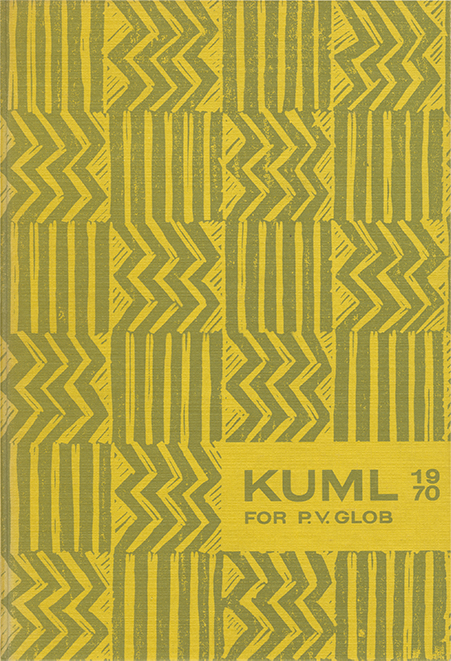To dobbeltgrave fra jysk enkeltgravskultur
DOI:
https://doi.org/10.7146/kuml.v20i20.105430Nøgleord:
dobbelgrav, double grave, enkeltgravskultur, battle-axe culture, single grave culture, glob, vester nebel, tønningResumé
Two double graves from the Jutland Battle-axe culture
In his thesis on the Battle-axe culture of Jutland, P. V. Glob mentioned a number of graves which on account of the unusual amount and position of their furnishings must contain double burials. It appears that not only a man and woman, but also two men can share a coffin (1).
In 1969 two such double men's graves were investigated, one at Vester Nebel north-west of Kolding and one at Tønning Wood, between Horsens and Silkeborg. These two finds are described below, and a carbon-14 dating is given for the Vester Nebel grave.
Vester Nebel
The grave at Vester Nebel was roughly circular and surrounded by a ring-ditch. It had almost vertical sides and was paved with stone (fig. 1-2). The use of a plank coffin was indirectly indicated by a stoneless groove near the southern edge of the paving (fig. 3).
Dispersed in the grave fill were 10 potsherds, including the decorated rim-sherd H (fig. 4) from the upper fill. On the paving were found the flint blade D, the amber ring E, amber disk M, battle-axes J and N, flint axes K and L (fig. 1, 5 and 6) and diverse pieces of charcoal.
The ring-ditch O surrounding the grave (fig. 1) was everywhere U-shaped in section and exhibited in the north-eastern part a distinct depression resembling a posthole. A peculiar channel established in the north-east an unequivocal connection between the ring-ditch and the rest of the grave. The presumed traces of an unsuccessful attempt at grave-robbery, T, were registered in the west (fig. 1) at the same level as the grave and the ring-ditch, which was seen to continue beneath this horizon. No traces of border stones were found.
The Vester Nebel grave belongs to the special group of graves from the Jutland Battle-axe culture called circular graves, of which 25 specimens have now been recorded (4). They are represented in the Under-grave period only. Ring-ditches are comparatively rare (5-6), but a circular grave with a ring-ditch has been found at Bjerregård in Vejle county (7).
The Vester Nebel grave is, on account of its unusual length and two battle-axes in the positions indicated, considered to be a double grave for two men. The well-made battle-axes J and N (fig. 6) may be assigned to Glob's type D and thus date the grave to the late Under-grave period (8). This archaeological dating is supplemented by a carbon-14 dating carried out by the National Museum in Copenhagen. This indicated 2200± 100 B.C. (9).
Tønning Wood
In connection with other excavations in Tønning Wood, Hellmuth Andersen investigated in 1969-70 a demolished barrow at the western edge of the wood (10). In the centre of the mound a primary grave from the Upper-grave period was found, and three metres to the south of this a secondary 4 m long stone-lined grave. This long grave was empty, but its general character and position suggest a close connection with the primary grave.
The primary grave was sunk into the sub-soil and had stonelined sides (fig. 7 and 8). At the west end was found the battle-axe D and the straight-walled earthenware beaker E, and at the east end the battle-axe C and the straight-walled beaker B (fig. 9 and 10). A piece of a flint blade, an undecorated potsherd and a damaged amber head were also found on the floor of the grave.
The battle-axe D is a well-formed specimen of Glob's L-type (11), and the pot E may be assigned to Glob's N-type (12) so that the grave inventory as a whole may be placed in the Upper-grave period. On account of the number of objects and their position, the grave must be regarded as a double one for two men.
As was mentioned in the introduction, the double grave is a recognized phenomenon of the Jutland Battle-axe culture, and in recent years, three further examples of this burial custom have been found (13). Double graves also occur in related culture groups outside Denmark (14), likewise with cases of two men being buried in one grave. It is, however, by no means clear how these two men have been related. As far as the manner of burial and the grave furnishings are concerned, nothing suggests that their relationship was one of master and servant. It must rather be a case of a kind of sworn brother relationship, an artifical kinship which is known from many cultures and which can mean fellowship in death and the grave for the parties concerned (15).
The double graves of the Battle-axe culture point forward in time, since corresponding burials are known from both the Late Neolithic (16) and the Early Bronze Age (17).
H. J. MadsenDownloads
Publiceret
Citation/Eksport
Nummer
Sektion
Licens
Fra og med årgang 2022 er artikler udgivet i Kuml med en licens fra Creative Commons (CC BY-NC-SA 4.0).
Alle tidligere årgange af tidsskriftet er ikke udgivet med en licens fra Creative Commons.


